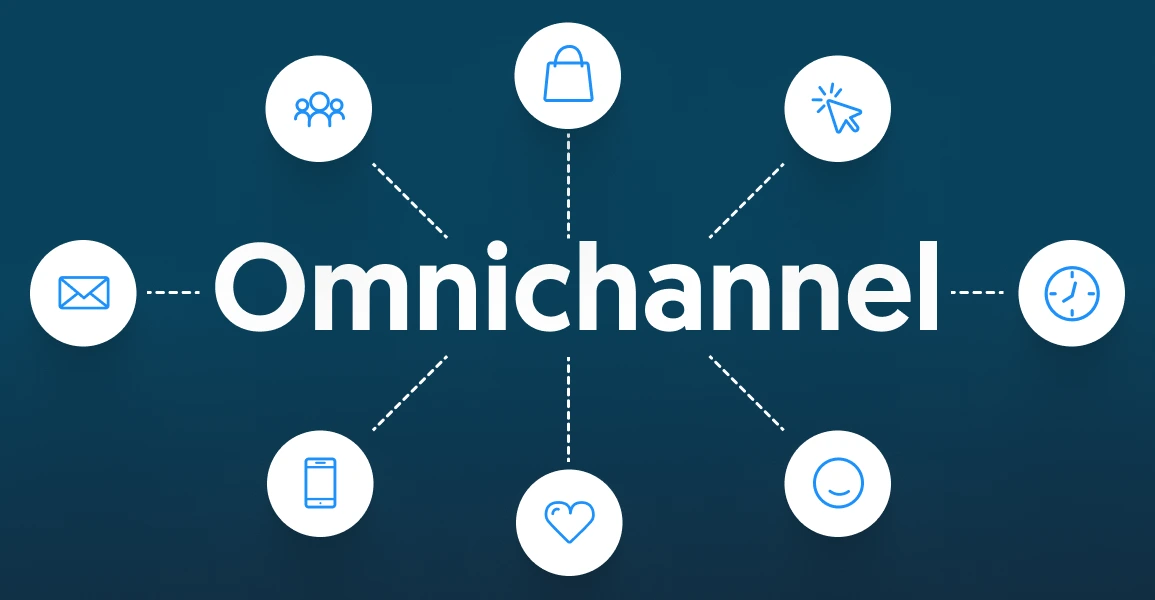An Ultimate Guide to Omnichannel Communication
Omnichannel communication is a powerful way to meet your audience in different ways throughout their digital daily life. Find out how.

On average, it takes more than 60 touchpoints for a B2B customer to complete a sale – and around 20 to 30 touchpoints for a B2C one to do the same.
This is a clear reflection of how the online buyer’s journey has changed over the last few years: modern consumers interact with brands through multiple platforms and expect seamless and consistent communication at every touchpoint.
Businesses need to adapt to meet these expectations by engaging customers where they are most active. And that is exactly where omnichannel communication comes into play. Sometimes looked at as a “new” thing, and sometimes dismissed because it “feels” complicated, omnichannel communication can be the key that helps you ensure your message gets across.
What is omnichannel communication?
Omnichannel communication refers to a unified strategy that integrates multiple communication channels to provide customers with a seamless experience. It ensures that regardless of the channel a customer uses—whether through social media, email, in-app chat, or SMS—they receive consistent and personalized interactions from a brand.
Unlike traditional multichannel approaches, which often operate in silos, omnichannel takes a customer-centric view, connecting all communication methods to create a cohesive narrative tailored to the individual. The goal is not just to be present on various platforms but to offer an interconnected experience that builds trust and deepens engagement.
In other words, omnichannel communication allows you to be where your customers are, in a way that feels natural and organic, as opposed to disconnected, repetitive, and intrusive.
Multichannel vs. omnichannel: key differences
At first glance, multichannel and omnichannel strategies can seem similar since both use multiple platforms to interact with customers. However, the difference lies in integration and the customer experience.
- Multichannel communication focuses on maintaining a presence across different channels without necessarily interlinking them. Each channel operates independently, often leading to fragmented or inconsistent messaging.
- Omnichannel communication, on the other hand, integrates all platforms into a cohesive system, ensuring customers receive a unified experience regardless of how they interact with the brand. For example, a customer can start an inquiry via live chat and receive a follow-up email seamlessly connected to that initial conversation.
Essentially, omnichannel communication is about holistic customer experience, while multichannel communication is about mere channel availability.
| Aspect | Multichannel Communication | Omnichannel Communication |
| Definition | Focuses on providing multiple, separate channels for customer interaction. | Integrates all channels into a unified system for a seamless experience. |
| Customer Experience | Interaction is often fragmented across platforms. | Ensures a consistent and cohesive experience across platforms. |
| Channel Connectivity | Channels operate independently of one another. | Channels are interconnected and share data. |
| Data Sharing | Limited or no sharing of customer data between channels. | Centralized data allows continuity in communication. |
| Example | A customer contacts support via email and must restate their issue on a phone call. | A customer starts a chat inquiry, and follow-ups continue via email seamlessly. |
| Focus | Availability of various channels. | Holistic integration of channels centered on the customer. |
What channels are included in “omnichannel”?
A well-implemented omnichannel strategy incorporates a variety of communication platforms to create a connected customer experience. Here are some of the most common channels utilized in omnichannel communication:
One of the most widely used digital channels, email remains a powerful tool for personalized communication (and a very profitable one too, with some reporting a ROAS as high as 4200%). Segmentation and tailored messaging can help brands send targeted emails that actually resonate with customers and encourage engagement.
Whether it’s promotional offers, abandoned cart reminders, or feedback requests, email anchors many omnichannel strategies, connecting everything together, and bringing comms towards a channel that feels more personal and direct.
Remember that email marketing does not have to be about automated emails only – your entire organization can contribute to how you distribute messages and promotions. For instance, implementing a centralized email signature management tool allows you to passively disseminate news, webinars, marketing assets, and special offers by embedding it into professional-looking email signatures across your entire organization.
Social media
Social media platforms like Facebook, Instagram, Twitter, TikTok, and LinkedIn provide unique opportunities for real-time interaction. These platforms allow brands to interact with vast audiences, run campaigns, and engage with customers through comments and direct messages.
Integrating social media into an omnichannel approach ensures customers receive consistent communications across every digital touchpoint. This strategy not only enhances brand loyalty but also creates a seamless user experience.
In-app messaging
For brands with dedicated mobile or desktop applications, in-app messaging provides a unique opportunity to interact directly with users. Personalized notifications or support chat integrated directly within the app create convenience for customers, enhancing the overall experience.
Push notifications
Push notifications on mobile devices ensure customers are reminded of relevant promotions, announcements, or updates in a timely manner. These short, efficient alerts are an essential touchpoint in an omnichannel strategy when used responsibly and tailored to the user’s needs and preferences.
Push notifications are very often used to relay urgency. Research shows that 40% of users interact with these notifications within an hour of receiving them (which goes to show that they do work for their intended purpose.)
Live chats
Live chat functionality on websites or within apps allows businesses to offer instant customer support. This real-time communication ensures a high level of customer satisfaction and plays a critical role in resolving issues quickly.
Additionally, live chats provide an opportunity for businesses to gather valuable customer feedback and insights. By addressing customer queries directly and engaging in meaningful conversations, companies can better understand user needs, identify common pain points, and improve their products or services accordingly. This proactive approach to customer interaction helps build trust and fosters long-term loyalty.
Chatbots
Powered by AI, chatbots have become an integral element of modern omnichannel strategies. Bots can engage customers 24/7, answer FAQs, and provide guidance tailored to user needs. Their efficiency and ability to operate across platforms make them invaluable.
SMS
According to research, SMS marketing boasts a staggering 98% open rate, considerably more than any other communication channel. And although it should definitely not be abused (remember: SMS is a far more personal channel than, say, email), it is worth noting that text messaging remains a highly effective and direct way to reach customers.
From appointment reminders to promotional offers, SMS ensures essential information is delivered promptly to users, making it a crucial tool in an omnichannel framework.
The benefits of omnichannel communication
Implementing an omnichannel communication strategy offers several key benefits for businesses aiming to thrive in an increasingly competitive digital landscape.
Increased customer satisfaction
By offering seamless communication across platforms, omnichannel strategies create a consistent and unified experience for customers, no matter how they choose to interact with a brand. This approach ensures that customers feel valued, understood, and supported at every touchpoint. As a result, businesses can build stronger relationships with their audience, leading to increased satisfaction and loyalty.
Boosted customer engagement
With personalized and consistent messaging across all channels, customers are more likely to engage with the brand in meaningful ways. Tailored messaging ensures that customers feel seen and understood, creating a stronger emotional connection with the brand.
When customers encounter familiar and relevant messages across platforms—whether it’s on social media, email, or in-store—they are more likely to resonate with the brand’s identity and values. This sense of connection fosters trust, which is a critical factor in driving engagement.
But omnichannel communication is not everything. Consistency also plays a key role in reinforcing brand recognition. By delivering aligned messages across different channels, brands can provide a seamless customer experience, making it easier for customers to interact. Whether it’s through inquiries, responses, or purchases, this unified approach removes barriers and encourages customers to take action. Over time, this not only boosts engagement but also strengthens customer loyalty, ultimately contributing to long-term business growth.
High ROI (return on investment)
A well-orchestrated omnichannel approach delivers a high return on investment by streamlining communication and ensuring marketing efforts effectively reach the right audience.
By integrating multiple channels—such as the ones listed in the previous section—businesses can create a seamless and consistent customer journey. This strategy not only improves engagement but also builds stronger brand loyalty, as customers feel understood and valued at every touchpoint.
With data-driven insights, an omnichannel approach allows businesses to tailor campaigns, maximize efficiency, and drive higher conversion rates, making it an essential tool for long-term growth and success.
Lower churn
When customers receive excellent and cohesive brand experiences, they’re more likely to remain loyal to the company. This consistency builds trust and a stronger emotional connection with the brand, making it more likely for customers to return.
An effective omnichannel strategy plays a pivotal role in delivering these seamless experiences by connecting touchpoints across online and offline platforms. This not only enhances customer satisfaction but also drives deeper engagement. By meeting customers where they are and ensuring their journey feels unified, companies can significantly reduce churn rates, foster loyalty, and ultimately increase customer lifetime value.
Gaining competitive advantage
Businesses that adopt omnichannel communication gain a significant advantage over competitors by delivering cohesive and integrated experiences across all touchpoints. By seamlessly connecting channels like email, social media, in-store interactions, and customer support, they create a unified journey that meets customers where they are.
This not only enhances convenience and satisfaction but also fosters deeper trust and stronger relationships. In today’s competitive market, this personalized and consistent approach is essential for nurturing long-term customer loyalty and driving sustainable growth. And if your competitors aren’t using good email signature examples, you have a clear competitive advantage over them if you show up with a polished, professional look–one inbox at a time.
Better quality data about your customers
By integrating communication across multiple touchpoints, companies can gather invaluable data on customer preferences, behaviors, and interactions.
This data provides insights into what customers want and reveals patterns that help businesses predict future needs and trends. With these insights, companies can refine their marketing strategies to deliver personalized, targeted campaigns that resonate with their audience.
Additionally, the data you collect using omnichannel marketing also enables your business to make your products and services better, because they can be more closely aligned with customer expectations. Ultimately, this approach fosters stronger customer relationships, drives loyalty, and leads to long-term growth.
Consistent communication
Omnichannel strategies ensure that customers receive the same brand message regardless of the channel, fostering trust and recognition.
This approach creates a seamless experience, whether customers are engaging through social media, email, or in-store. By unifying communication, brands can build stronger relationships and drive long-term loyalty.
Personalized messaging
Through customer data and behavior analysis, omnichannel communication enables brands to send personalized, relevant content that aligns with customer needs, increasing the likelihood of positive responses.
It all circles back to consistency and data quality: with both in place, businesses can tailor messages to resonate with specific audience segments and build stronger emotional connections. This personalized approach not only drives engagement but also fosters long-term loyalty.
How to create an omnichannel strategy
Creating a successful omnichannel strategy requires careful planning and execution. Here are some core tips you can keep in mind to build an effective approach:
Multichannel integrations
To create an omnichannel strategy, you must first ensure all communication platforms—email, email signatures, social media, chat, and others—are fully integrated to function as a unified system. This integration is critical for providing a consistent and seamless experience across all touchpoints.
When platforms work together, businesses can streamline workflows, reduce response times, and maintain a cohesive brand voice. On the other end of the communication, customers benefit from receiving timely and personalized interactions, regardless of the channel they use.
When you connect your communication tools, your business enhances customer satisfaction and improves team collaboration and efficiency, making it easier to track, manage, and optimize every interaction.
Consistency in branding
All messaging across channels must consistently reflect the brand’s voice, tone, and identity. This consistency is crucial for building trust with your audience, as it creates a sense of reliability and professionalism.
A unified message across platforms also strengthens brand recognition, ensuring your audience immediately identifies and connects with your brand, no matter where they encounter it, which makes your business more credible and more likely to be remembered.
Providing personalized experiences
Remember what omnichannel is all about and make sure your strategy always puts the customer first. The goal is to provide a seamless and consistent experience, so your messaging must be tailored to meet the needs of specific audience segments.
Use data and analytics, gather insights into customer behaviors, preferences, and pain points. Use this valuable information to create targeted campaigns that resonate with different audiences on a personal level.
Cross-channel data
For omnichannel communications to really work, it’s important to remember to centralize customer data from all channels into a single system ensures insights are readily available and streamlined. Data hygiene and a good digital transformation strategy become paramount here, as it guarantees the data is accurate, relevant, and up-to-date.
Additionally, this centralization makes it easier to optimize campaigns in real-time by providing a comprehensive view of customer interactions and behaviors across all channels.
Set KPIs for every channel
Omnichannel marketing does not mean you shouldn’t set individual KPIs for each channel. On the contrary, understanding how each channel performs gives you a clearer picture of your overall strategy’s effectiveness.
Set measurable goals, or key performance indicators (KPIs), for each channel. Tracking performance helps pinpoint what’s working and where adjustments are needed.
Who should use omnichannel?
Omnichannel communication is beneficial across a wide range of industries and sectors. Retailers, financial institutions, healthcare providers, educational organizations, and beyond can implement an omnichannel strategy to improve customer relationships, drive loyalty, and streamline operations. Any business focused on customer satisfaction and seamless experiences will find omnichannel approaches essential for sustained success.
That being said, there are situations where omnichannel communications might just not be necessary. For example, small businesses with a limited budget and customer base might find it more efficient to focus on a few key channels rather than trying to implement an omnichannel approach. Ultimately, the decision to use omnichannel should align with your business goals and resources.
Bonus: example of an omnichannel strategy
Imagine a clothing retailer uses the following omnichannel approach:
- A customer sees an ad on Instagram and visits the website for more details.
- They initiate a live chat with a customer service representative to inquire about sizing.
- The customer decides to purchase the item and opts for in-store pickup.
- They receive a confirmation email and push notification when their order is ready for pickup.
- While in-store, the customer browses other items and receives personalized recommendations through an in-app chatbot.
- Upon leaving the store, they receive a text message with a discount code for their next online purchase.
- After making another purchase online, the customer receives an email thanking them for their loyalty and offering a personalized discount on their next in-store visit.
- During checkout at a physical store, the cashier asks if the customer would like to sign up for SMS notifications about sales and new arrivals.
This example showcases a seamless and personalized omnichannel experience, demonstrating the potential of an effective strategy in driving customer satisfaction and loyalty. Overall, businesses across industries can benefit greatly from implementing omnichannel communication to create cohesive, efficient, and personalized experiences for their customers. By paying attention to user needs and continuously refining approaches through data analysis, companies can ensure they stay at the forefront of customer communication in today’s digital landscape.
Time to embrace omnichannel communications in 2025
Technology evolves – and so do customer preferences and expectations. Your business must meet your audience halfway, and omnichannel is one of the best ways to do it.
Keep in mind omnichannel is not a set-it-and-forget-it type of strategy. It feeds into the larger goal of understanding and nurturing customer relationships. To be successful with omnichannel, your business must continuously collect and analyze data, adapt to changing trends and technologies, and provide consistent and personalized experiences across all channels.
Don’t wait until it’s too late. Start implementing an omnichannel strategy today and stay ahead of the game. More than anything, remember to measure and adjust as you go – consumer preferences, markets, and technology can change quickly, so stay agile and adaptable in your approach.

